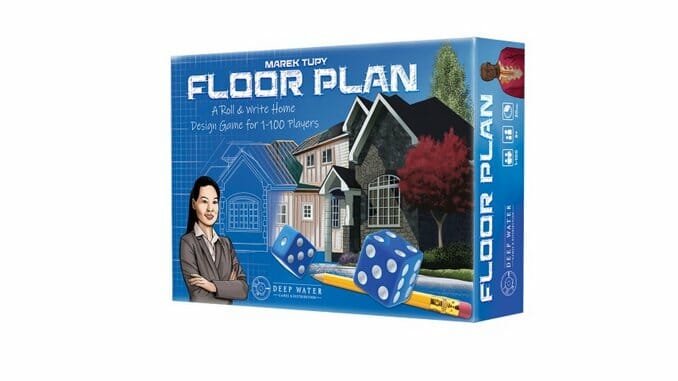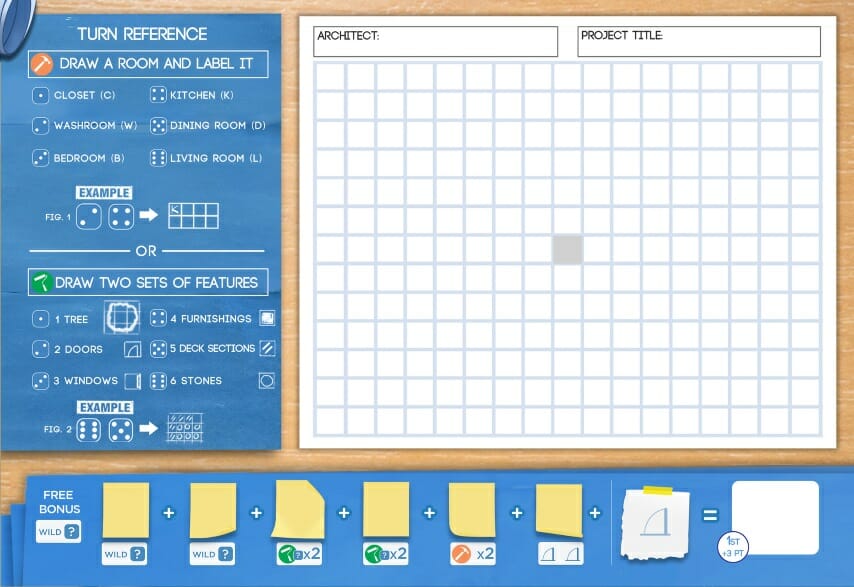The Roll-and-Write Board Game Floor Plan Rewards You For Building Impractical Houses Like a Rich Fool
Games Reviews board games
Deep Water Games had a massive hit a few years ago with Welcome To…, a “flip-and-write” game that scales to any number of players—they held an event at Gen Con for up to 200 players at one time, and the box even says 1 to 100 can play it at once—and has a very short learning curve for new players. Their newest release, Floor Plan, is an obvious follow-up to Welcome To… in theme and scale, using dice instead of cards, but really requires you to think beyond its theme to understand how to play the game well. It’s a better abstract game than thematic one.
In Floor Plan, players use the rolls of a pair of dice to simultaneously fill in their grids with six types of rooms or six different types of features to satisfy the demands of clients, shown on three cards that are drawn randomly in each game. Those cards show five different combinations of rooms and features that will score you points (from 4 to 12 points per bonus, and you can hit the same bonus several times), plus one game-end bonus worth one or two points based on your placement of doors around your house; that last one is easier to achieve but is distinct from everything else you’re doing.
On every roll of the dice, each player must choose whether to use the results to draw one room or choose two features. Each die value is tied to a room type, and you may use the results of the roll to draw either room type based on those values, drawing a room of the size shown on the two dice. So, for example, if the roll shows a 3 and a 5, you may draw a 3×5 or 5×3 room and label it a Dining Room (5) or a Bedroom (3). You can draw this anywhere on your grid, even if it’s detached from the rest of your house.
Your other option is to use the two dice separately to draw features—trees, doors, windows, furniture, decks, or stones (which enclose empty squares that become pools). You must use both dice, and draw everything they give you; since furniture is the feature for a die value of 4, you must fill in four squares in existing rooms to show those spaces are furnished. These features will typically score in combination with something else—a tree adjacent to a bedroom with a window overlooking it; a pool of at least eight water squares that’s adjacent to at least eight squares of deck.

Floor Plan also gives you a few opportunities to change the dice or gain additional benefits. You start the game with one free wild card, which you can use to treat a single die as if it had any value you choose. When you complete your first and second card bonuses, you get additional wild cards. Your third and fourth card bonuses get you the power to double the value of any feature—so, since a die value of 5 gets you five deck squares, you could use this one-time ability to shade in 10 squares instead. Your fifth card bonus lets you draw the same room twice off one roll of the dice, and the sixth bonus lets you draw two doors for free. When any player triggers their sixth bonus, it ends the game, after which all players complete that turn, scoring the game-end door bonus, and adding up all points from completed card bonuses, with all players who finished their sixth bonus on that turn getting three additional points.
To rack up points in Floor Plan, you have to forget the theme completely. You’re not designing a house; depending on the scoring cards for that particular session, you may not need a kitchen or a washroom at all, but might want to make a house with six bedrooms and one closet, or build a tiny house with a huge deck and multiple pools. It doesn’t have to make sense to be worth a lot of points; in my plays, the higher-scoring houses often didn’t make sense at all. This was harder for the youngest player in the house to try the game, because she wanted to add rooms to her house that were logical, and I think she also considered the aesthetics and layout, when there’s no point value to that stuff at all. Forget that this is a house, or maybe assume it’s a house designed by a rich fool. Either way, though, you’ll find it way easier to hit six goals and rack up a large point total if you stop thinking about what you draw as a coherent home.
Like most roll-and-writes, Floor Plan comes with instructions for playing the game solo, comparing your score to a chart provided in the rules. The solo mode limits the total number of dice rolls you can make to 17, one for each square across the bottom row of your scoresheet, which you’ll fill in as you roll and thus can’t use for rooms or features. The remainder of the solo rules are the same as the regular rules, since the competitive game has no real interaction between players (common in roll-and-writes, but not universal), making solitaire play much easier.
Floor Plan does do one thing I haven’t seen in any new board games, although I hope it becomes more common. The fifteen client cards have drawings of the clients with names and their pronouns, with visible diversity and use of the singular they/them for several such clients. It has no impact on game play, but is a definitive choice towards inclusion, and something I appreciate and would like to see other designers emulate going forward.
Welcome To… is still the king of roll-and-write or flip-and-write games in our house, especially with so many expansions available for the base game, tweaking the scoring with new pads that change how you’ll fill in your neighborhoods. It’s also so thematically tight that it’s hard for Floor Plan to measure up given the disconnect here between the theme and the strategy you need to score a lot of points. That makes Floor Plan a good game if you’re looking for a change from other roll-and-writes, but keeps it out of the top tier of this style.
Keith Law is the author of The Inside Game and Smart Baseball and a senior baseball writer for The Athletic. You can find his personal blog the dish, covering games, literature, and more, at meadowparty.com/blog.